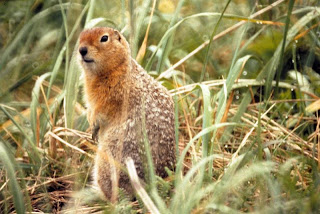As I sort through the news each day looking for things to cover in my posts on Geekosystem I come across a lot of science stories that are interesting to me, but that don’t really fit within the confines of what we do on the site. I’ve been saving some of these stories to blog about here whenever I get a chance.
One of these tidbits was a study about ground squirrels and how researchers have figured out a way to induce hibernation. Researchers from the University of Alaska, Fairbanks interested in studying the biological processes that cause animals to hibernate have found a way to make them go into this state. The research was conducted on arctic ground squirrels.
 |
| Source Wikipedia Commons |
Now you might be asking yourself, what is a ground squirrel and is it any different than a regular old squirrel that you see in your backyard? Squirrels are part of a family of small rodents called Sciuridae, this includes your tree squirrels, ground squirrels, chimpmunks, marmots (woodchucks), flying squirrels, and prairie dogs. A ground squirrel (not surprisingly) tends to live on the ground rather than in trees.
The University of Alaska researchers wanted to study a condition called torpor in ground squirrels. When an animal hibernates its heart rate and blood flow become reduced. In a human this would cause brain damage, but that doesn’t happen in animals that hibernate. Animals that hibernate survive being in this state by reducing their metabolism – this is called torpor. When an animal is in torpor its oxygen consumption can fall to as low as one percent of its resting metabolic rate and its core body temperature can drop to near freezing. In hibernating animals a molecule called adenosine plays a role in entering this state by slowing down nerve cell activity.
The researchers discovered that if they administer a caffeine-like substance that stimulates the areas of the brain that are receptive to adenosine they could control the ground squirrels’ hibernation. The researchers woke six ground squirrels in the middle of their hibernation season using this substance, and were able to then induce a torpor state by taking away the substance in all of the ground squirrels.
The researchers also tried this with six ground squirrels that were woken early in their hibernation season and were only able to induce torpor in two. During the summer season when ground squirrels are not hibernating, the researchers weren’t able to induce them into a torpor state. The research was published in the Journal of Neuroscience.
So why does the ability to wake up sleeping squirrels matter in the slightest? Well, understanding how animals survive the reduced blood flow, heart rate, and body temperatures that come along with being in hibernation could help scientists develop new ways to treat patients who have had a stroke or another traumatic incident where blood flow to the brain is reduced. That kind of an application is a long way off, but this research is still a significant step forward in understanding the biological mechanisms that underly hibernation.